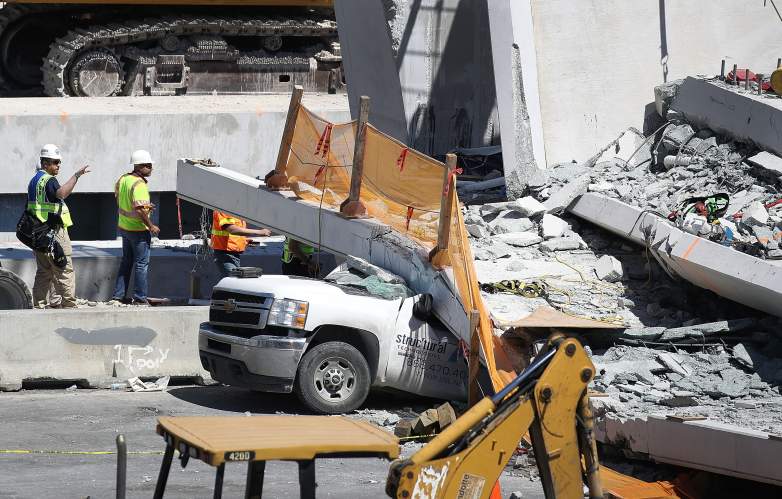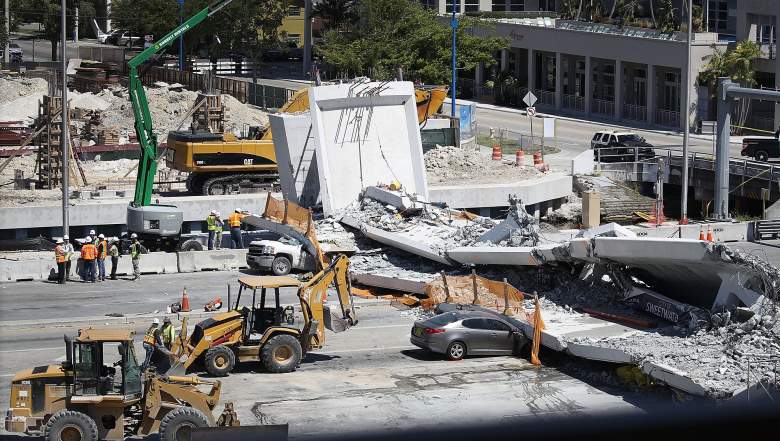W. Denney Pate, 61, is a lead engineer for Figg Bridge Engineers, the company that partnered with Munilla Construction Management (MCM) to design and build the UniversityCity Bridge at FIU that collapsed Thursday, killing at least six people. A couple days before the bridge collapsed, Pate had left a voicemail with the Florida Department of Transportation, sharing that a crack had been noticed in the bridge, but that Figg didn’t think it posed a safety issue. FDOT didn’t get his voicemail until Friday because the person he called was out of the office. Here are more details about Pate.
1. Pate Called the Florida Department of Transportation a Couple Days Before the Collapse and Said ‘Some Cracking’ Had Been Observed

GettyMembers of the National Transportation Safety Board investigate the scene where a pedestrian bridge collapsed a few days after it was built.
Just a couple days before the bridge collapsed, W. Denney Pate, Figg’s lead engineer responsible for the project, called the Florida Department of Transportation and said “some cracking” had been observed and some repairs would have to be done, but they didn’t think there were any safety issues. The FDOT message was not heard until Friday, because the employee that Pate called had been out of the office. WFLA provided a transcript of the phone call, which you can read below:
“Hey Tom, this is Denney Pate with FIGG bridge engineers. Calling to, uh, share with you some information about the FIU pedestrian bridge and some cracking that’s been observed on the north end of the span, the pylon end of that span we moved this weekend. Um, so, uh, we’ve taken a look at it and, uh, obviously some repairs or whatever will have to be done but from a safety perspective we don’t see that there’s any issue there so we’re not concerned about it from that perspective although obviously the cracking is not good and something’s going to have to be, ya know, done to repair that. At any rate, I wanted to chat with you about that because I suspect at some point that’s gonna get to your desk. So, uh, at any rate, call me back when you can. Thank you. Bye.”
You can hear Pate’s voicemail here or listen to it below. It’s not clear at this time if the cracking was a contributing factor in the collapse. The cracking observed on the north end of the structure, which early reports say may have been the part of the bridge that failed, The Miami Herald reported. However, cracks aren’t always unusual in concrete construction and sometimes are just cosmetic. Until the National Transportation Safety Board completes its investigation, it won’t be known what caused the collapse or if the cracks played a role. It may take months or longer for the NTSB to complete its investigation.
The voicemail was left on a landline, so it wasn’t heard until Friday, March 16. The employee he left the voicemail with was out of the office on an assignment, FDOT said in a press release.
2. Pate Has Been with Figg for More Than 30 Years
Pate has worked with Figg for more than 30 years, for his entire career. He joined Figg right out of graduate school in 1980, Florida Trend reported in a 2006 story about trendsetters. He dreamed of designing bridges since he was eight, growing up in Alabama, the American Road & Transportation Builders Association noted. In fact, he even designed his own bridges as a child, building them across creeks in the woods where he lived. Pate got his bachelor’s and master’s in civil engineering from Auburn University.
The Florida Department of Transportation said about the voicemail: “The responsibility to identify and address life-safety issues and properly communicate them is the sole responsibility of the F.I.U. design-build team. At no point during any of the communications above did Figg or any member of the F.I.U. design-build team ever communicate a life-safety issue.”
A spokesman for Figg told the Miami Herald on Friday: “The evaluation was based on the best available information at that time and indicated that there were no safety issues. We will pursue answers to find out what factors led to this tragic situation, but it is important that the agencies responsible for investigating this devastating situation are given the appropriate time in order to accurately identify what factors led to the accident during construction.”
The bridge schematic for the collapsed bridge has Pate’s engineering stamp on it:
3. Pate Designed a New Cradle System for Cable-Stayed Bridges That Was Lauded by The History Channel
Pate was inducted as a Hall of Fame member into TDF in 2011 because of a “revolutionary” cradle system he had developed for cable-stayed bridges. (You can see the video about his induction above.) The system was said to reduce initial construction costs. The History Channel’s Modern Marvels series labeled his invention as “one of the top 25 inventions.” The cradle was his first patent. He came up with the idea in 2000 while working on a Toledo, Ohio bridge.
Pate has designed numerous bridges for Figg, including the Zakim bridge in Massachusetts.
4. Figg Said They Were Stunned by the Collapse & Are Fully Cooperating with Authorities
GettyMembers of the National Transportation Safety Board investigate the scene where a pedestrian bridge collapsed a few days after it was built.
Figg said in a statement that it was stunned by the bridge collapse. “Our deepest sympathies are with all those affected by this accident. We will fully cooperate with every appropriate authority in reviewing what happened and why. In our 40-year history, nothing like this has ever happened before. Our entire team mourns the loss of life and injuries associated with this devastating tragedy, and our prayers go out to all involved.”
In February 2016, it was announced that MCM and Figg Bridge Engineers would partner to build the UniversityCity Bridge. The pedestrian bridge cost $9.3 million, and MCM-FIGG were also contracted to build other related streetscape elements that would link Sweetwater with the northern entrance of FIU over Southwest 8th Street, FIU reported. FIU, the Federal Highway Administration, and the Florida Department of Transportation all approved the selection of MCM. Sweetwater and Miami-Dade Transit also participated in the selection process. The bridge was part of an $11.4 million UniversityCity Prosperity Project, which would also included improving entrances to MMC and the 109th Avenue area, along with partnering with IBM to create a Smart Parking Software System. They completed the FIU Football Stadium Expansion in August 2012.
5. At Least Six People Died in the Florida Bridge Collapse
At least six people died after the pedestrian bridge at Florida International University collapsed. That number could rise as rescue efforts continue. Authorities have not identified all the victims yet. One was FIU student Alexa Duran, who was crushed in the driver’s seat of her car. Her friend who was in the passenger seat survived. Navaro Brown, 37, a bridge worker, also died, said Michael Biesiada, a spokesman for Structural Technologies VSL, according to The Miami Herald.
Five of the deceased were found trapped in rubble under the bridge. Ten people were rushed to Kendall Regional Medical Center’s trauma unit. Of those 10, two were in critical condition and eight were expected to be OK.
The tragedy is being investigated as a homicide investigation, authorities said on March 16 during a press conference. They have to determine the cause of the collapse before knowing if they will pursue criminal charges.
